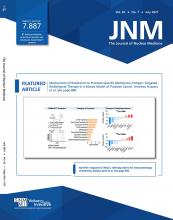TO THE EDITOR: We read with great interest the insightful article by Dr. Farolfi and colleagues (1) recently published in The Journal of Nuclear Medicine and describing patterns of prostate cancer recurrence after salvage lymph node dissection (sLND). Data provided by the authors add significantly to the current literature and improve our understanding of potential pitfalls that might determine suboptimal results after metastasis-directed therapies.
In a series of 16 men who had prostate-specific antigen persistence after sLND, Dr. Farolfi and colleagues compared the results of preoperative versus postoperative prostate-specific membrane antigen (PSMA) PET scans and found that 63% of patients had a postoperative scan positive for cancer recurrence in locations already described on preoperative imaging. Although the precise surgical template was not specified by the authors, all positive regions on the preoperative PSMA PET scan were surgically explored, with a median of 17 nodes removed. However, whereas preoperative PSMA PET scans identified 24 positive spots, the final pathologic report resulted in 88 positive nodes. This finding further underlines the likely underestimation of tumor burden on imaging (2, 3) and reiterates the importance of a thorough surgical dissection, including the obturator and internal iliac nodes, which were the sites most often involved by PSMA PET persistence after sLND (1). In fact, an incomplete surgical resection might be among the reasons explaining the worse-than-expected outcomes of sLND at long-term follow-up (4, 5). Therefore, while we await prospective evidence on this issue, an extended, bilateral surgical template should be recommended whenever pelvic sLND is contemplated, with the exception being men who have only a single spot on the preoperative PSMA PET scan and might safety undergo a unilateral (yet extended) surgical dissection (6).
The adoption of an adequate template is key to maximizing the potential benefit associated with metastasis-directed therapies, a rationale that pertains to sLND as well as to radiotherapy (7–10). This benefit was further confirmed by Dr. Farolfi and colleagues, who should be commended for their important contribution, which has relevant implications for clinical practice. Now more than ever, these data should be borne in mind whenever metastasis-directed therapies are contemplated, and physicians should be aware of the risk of unsuccessful metastasis-directed therapy in cases of a suboptimal treatment template.
- © 2021 by the Society of Nuclear Medicine and Molecular Imaging.







